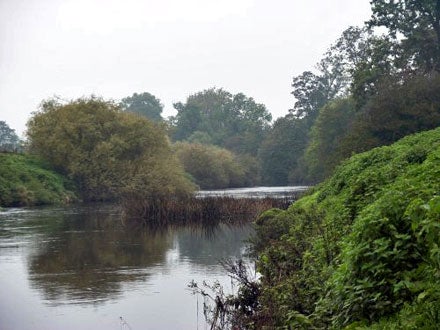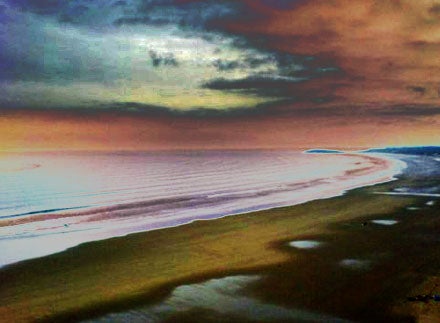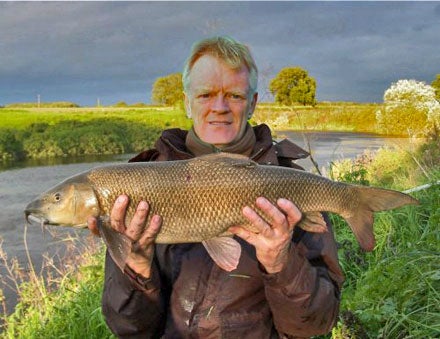| SEAN MEEGHAN | |
Fishing the Yorkshire Rivers for Barbel Part 6 – AutumnI THING AUTUMN is my favourite season. The nights are drawing in and water temperatures are dropping. Soon my thoughts will be turning to pike, but for the moment barbel still take priority.
Last week I stole a few hours on the river Don before heading South for what will be one of my last surfing trips of the year. I was rewarded with my smallest barbel ever at about 6oz and one of about 5lb. It’s a bit early yet for the Don as I normally fish it later in the year when it can be a degree or two warmer than the North Yorkshire rivers. The surfing was memorable for the sight of bass swimming along the breakers as I sat ‘out back’ on a Welsh storm beach in Clive Gammon country. Angling Magazine in the 70s: those were the days! (‘my friend’, if you’re really sad!).
Today I’ve arranged to fish the Swale with two old friends, Martin and Pete. As the weather was unsettled we kept a careful eye on River Line over the few days before the trip and were ready to switch to another river if we thought conditions would be better there. I had to work on Saturday morning, so having decided to stick to our original choice of venue we arranged to meet at the chippie in Boroughbridge, for a bite to eat before heading for the river. A glance at the river as we crossed Thornton Bridge revealed that the level was up a couple of feet with a good colour. The river had dropped about a foot since the level was given on River Line and probably about 2ft since Friday morning. It’s never going to be easy fishing in these conditions at this time of year, but there’s always a chance of a biggie. We parked up towards the bottom of the length as there were some cars in the top car park and settled down in some classic floodwater swims. I chose a crease below a rush bed which I knew had ‘form’ at this time of year. I soaked some mixed pellets and attached a cage feeder with a dead cow to my lead clip. I made several casts in quick succession to get some feed down, banded an 8mm pellet onto my size 14 hook and settled back in my chair. An hour and a half passed without any action and I decided to make a move upstream. After a long hike I walked past the last of the anglers upstream of me and started the search for a likely swim. I was looking for two features: a ‘barbel bush’ on my bank and a bit of steadier water above it. Eventually I found a likely looking swim with a nice crease above an overhanging bush. As I made my way down to the water I noticed fresh footprints in the mud. Mmm, had someone fished here earlier? I sat down and studied the swim closely, trying to work out where a fish would be lying and where the previous occupant of the swim might have put any feed. As I did this my mobile rang and I started a desultory conversation with my girlfriend. <>“You sound distracted.” “Mmm.” “What are you doing?” “Looking at the river.” She soon realised that she was onto a loser and rang off. After contemplating the swim for a few more minutes I decided that the deeper water would lie some feet out from the bush on the main flow side of the crease and that the previous occupant of the swim might well have fed closer to the bush. I decided to put a small amount of feed into the deeper water and fish a cage feeder to keep a trickle of pellets going into the swim. I put two half droppers of mixed pellets into the deeper water and was rewarded with a countdown that indicated about 8ft of water: perfect. I swung my feeder out into the flow, placed my rod in the rests and settled back in my chair. The phone rang again. This time it was my mate Mick, who was fishing with the ‘Barbel Catchers’ on the Yorkshire Ouse. As might be expected this conversation was a bit more animated. Mick’s tale of a mass blank on the Ouse was rudely interrupted by my rod tip nodding twice and slowly pulling round. “I’m in! Ring you back!” I piled the pressure onto a really good fish to stop it making a dash for the bush, but it had other ideas and plodded out into the powerful flow. Five minutes of stalemate followed with the barbel making short powerful runs and me regaining line until it held station in front of me. Gradually the pressure began to tell and I saw my feeder break the surface. I still couldn’t see the fish because of the colour, but a large boil betrayed a heavy fish. Gradually I worked her out of the current into the slacker water close to the bank until she rolled on the surface showing a deep, bronze flank. “Don’t lose it now Meeghan!” I gradually worked her over the rim of the net and lifted her gently from the water. Looks like a double! Now you’ve heard me say this before, but this time I was confident enough to ring Mick back whilst the fish was having a breather in the net and announce that I’d had a double. I also rang Martin (Pete is a grumpy northern version of Chris Yates and doesn’t possess a mobile) to ask him if he would make the long hike up to my swim to take a photo. While waiting for Martin to arrive I weighed the fish (10lb 5oz), put her back into my landing net and did a quick celebratory jig!
Some time later Martin and Pete arrived, did the photography bit and watched me return the fish. Unfortunately I didn’t notice until it was too late that the low, bright sun had ‘burnt out’ part of the pictures, a common problem with digital cameras. Never mind, the fish came out OK! The rest of the afternoon passed without another fish and I packed up about 6.30 to make the long trudge back to the car. On the way I stopped to chat with a well known Yorkshire barbel angler. He and his friend had blanked despite moving swims several times. His first swim had been the one where I caught the double, but I couldn’t bring myself to tell him this and just told him the weight and the rough location. On returning to the car Martin informed me that he’d had a barbel of 7lb 12oz late on then Pete turned up and announced a blank. Not a bad team result for the conditions. Lessons Learned OK, so I caught a double! That just makes the story a bit more interesting and makes for better pictures, but it doesn’t change the lessons learned and I would expect that Martin and the WKYBA would give you the same advice. So what did I learn?
This is probably the last article in the series. I’m not a year round barbel angler and the call of predatory fish is strong. I hope you’ve enjoyed the series and learnt as much as I have from doing it. If we get some good warm floods during the winter I might be tempted to catch a winter barbel and I’ll keep you posted on how I do. Until then ‘Tight Lines’ and I’ll see you on one of the forums for a chat. |













